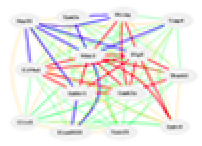|
Function
|
Command
keyword-value
|
Other keywords
(bold keywords are required)
|
Allowed values
[Comments or descriptions in square brackets]
|
| Retrieve genotype data |
cmd=genotype
cmd=gen |
riset |
axb, bxa,
bxd, bxh, cxb |
| |
|
chr (3) |
1, 2,
3, ..., 19, X |
| |
|
format (4) |
row, column |
| Example: http://robot.genenetwork.org/webqtl/main.py?cmd=genotype&riset=BXD&chr=1&format=column |
| |
| Retrieve trait data |
cmd=get
cmd=trait
cmd=tra |
probeset (1) |
[Probe or probeset identifier, trait record number
(for db=3), or marker name (for db=4)] |
| |
|
db |
Each database stored in GN is assigned a short code required to identify the particular database from which you would like to retrieve data.
|
| |
|
probe (1) |
all pm mm
OR
[Affymetrix cell location code] (3) |
| |
|
format (4) |
row, column |
| Example: http://robot.genenetwork.org/webqtl/main.py?cmd=get&probeset=98332_at&db=bra08-03MAS5&probe=119637&format=col |
| |
| Single-marker regression |
cmd=map |
probeset (1) |
[Probe or probeset identifier, trait record number
(for db=3) or marker name (for db=4)] |
| |
|
db |
Each database stored in GN is assigned a short code required to identify the particular database from which you would like to retrieve data.
|
| |
|
probe (1) |
all
[Affymetrix cell location code] (2) |
| |
|
return |
number of LRS values to be reported; all LRS are reported if omitted |
| |
|
sort |
lrs [sorts by descending pvalue]
[sorts by ascending position by default] |
| Example: http://robot.genenetwork.org/webqtl/main.py?cmd=map&probeset=98332_at&db=bra08-03MAS5&sort=lrs&return=20 |
| |
| QTL interval mapping |
cmd=interval
cmd=int |
probeset (1) |
[Probe or probeset identifier, trait record number
(for db=3), or marker name (for db=4)] |
| |
|
db |
Each database stored in GN is assigned a short code required to identify the particular database from which you would like to retrieve data.
|
| |
|
probe (1) |
[Affymetrix cell location code] (2) |
| |
|
chr |
1, 2,
3, ..., 19, X |
| |
|
sort |
lrs [sorts by descending pvalue]
[sorts by ascending position by default] |
| Example: http://robot.genenetwork.org/webqtl/main.py?cmd=interval&probeset=98332_at&db=bra08-03MAS5&chr=1 |
| |
| Trait correlation search |
cmd=correlation
cmd=cor
cmd=pearson
cmd=pea
cmd=spearman
cmd=spe |
probeset (1) |
[Affymetrix probeset identifier, trait record number
(for db=3) or marker name (for db=4)] |
| |
|
db |
Each database stored in GN is assigned a short code required to identify the particular database from which you would like to retrieve data.
|
| |
|
searchdb |
Each database stored in GN is assigned a short code required to identify the particular database from which you would like to retrieve data.
|
| |
|
probe (1) |
[Affymetrix cell location code] (2) |
| |
|
return |
[Maximum number of correlations to be reported] |
| |
|
sort |
pvalue [sorts by ascending
pvalue]
[sorts by descending correlation by default] |
| |
|
id |
yes [Includes NCBI Entrez Gene ID for each transcript in the output (for expression data only).]
only [Returns only NCBI Entrez Gene ID for each transcript (for expression data only).] |
| Example: http://robot.genenetwork.org/webqtl/main.py?cmd=cor&probeset=100001_at&probe=136415&db=bra08-03MAS5&searchdb=BXDPublish&return=500&sort=pvalue |
| |
| Open Trait Data and Analysis Form |
cmd=show
cmd=shw |
probeset (1) |
[Affymetrix probeset identifier, trait record number
(for db=3) or marker name (for db=4)] |
| |
|
db |
Each database stored in GN is assigned a short code required to identify the particular database from which you would like to retrieve data.
|
| |
|
probe (1) |
[Affymetrix cell location code] (2) |
| Example: http://gn1.genenetwork.org/webqtl/main.py?cmd=show&db=HC_M2_0606_M&probeset=1415670_at&probe=269753 |
| |
| The script below is used to filter a list of probes or probe sets that target the same gene or transcript to find the single probe or probe set with highest expression and to then display the Statistics Page for that particular data. This script does not use the cgi-bin format. |
| Show Best Trait Data Statistics Page |
parameters
|
examples
|
Notes |
| |
gene=
refseq=
geneid=
database=
searchAlias= |
gene=Rho
refseq=NM_145383
geneid=212541
database=Eye_M2_0906_R
searchAlias=1 |
There are three supported search term types: 1. Gene symbol, 2. RefSeq identifier, 3. Entrez gene identifier. Although not recommended, the string "&searchAlias=1" can be added at the end of the command to retrieve data using the alias of a proper gene symbol when the original does not work. Thus "gene=RP4" will resolve to "gene=Rho" only if you add "&searchAlias=1" at the end of the command.
Each database stored in GN is assigned a short code required to identify the particular database from which you would like to retrieve data.
|
| Example 1: http://gn1.genenetwork.org/webqtl/main.py?FormID=showBest&gene=Rho&database=HC_M2_0606_P |
| Example 2: http://gn1.genenetwork.org/webqtl/main.py?FormID=showBest&refseq=NM_145383&database=HC_M2_0606_P |
| Example 3: http://gn1.genenetwork.org/webqtl/main.py?FormID=showBest&geneid=212541&database=HC_M2_0606_P |
| Example 4: http://gn1.genenetwork.org/webqtl/main.py?FormID=showBest&gene=RP4&database=HC_M2_0606_P&searchAlias=1 |
| This script was originally written to allow connections from the NEIBank to GeneNetwork by H. Li and R. Williams (see News of April 25, 2007). |
| |
| Search for gene data |
cmd=search
cmd=sch |
gene
refseq
genbankid
|
The name or ID of the gene or protein to be searched, choose one and only one type of identifier |
| |
|
alias |
[0 or 1] Whether to search for possible aliases (only when a gene name is supplied), optional, disabled by default (0) |
| |
|
species |
Optional, only human, mouse and rat are supported now. Default is mouse if not specified. |
| |
|
tissue |
Optional, if not specified, display traits from all available tissues. For tissue abbreviations, please check http://gn1.genenetwork.org/webqtl/main.py?cmd=help&topic=tissue |
| |
|
format |
[html or text], Optional, if not specified, return result in HTML format |
Example 1 :
http://gn1.genenetwork.org/webqtl/main.py?cmd=sch&gene=ddx25
Example 2 :
http://gn1.genenetwork.org/webqtl/main.py?cmd=sch&refseq=NM_133594&species=rat
Example 3 :
http://gn1.genenetwork.org/webqtl/main.py?cmd=sch&genbankid=AW047046
Example 4 :
http://gn1.genenetwork.org/webqtl/main.py?cmd=sch&gene=GRTH&alias=1&species=rat&tissue=fat
Example 5 :
http://gn1.genenetwork.org/webqtl/main.py?cmd=sch&gene=Grin2b&tissue=hip&format=text
|
| |








 menu_grp1
menu_grp1